Zeros of Polynomials
In Exercises 1-6, use direct substitution
to show that the given value is a
zero of the given polynomial.
1. p(x) = x3 − 3x2 − 13x + 15, x = −3
2. p(x) = x3 − 2x2 − 13x − 10, x = −2
3. p(x) = x4 − x3 − 12x2, x = 4
4. p(x) = x4 − 2x3 − 3x2, x = −1
5. p(x) = x4 + x2 − 20, x = −2
6. p(x) = x4 + x3 − 19x2 + 11x + 30,
x = −1
In Exercises 7-28, identify all of the
zeros of the given polynomial without
the aid of a calculator . Use an algebraic
technique and show all work (factor
when necessary) needed to obtain the
zeros.
7. p(x) = (x − 2)(x + 4)(x − 5)
8. p(x) = (x − 1)(x − 3)(x + 8)
9. p(x) = −2(x − 3)(x + 4)(x − 2)
10. p(x) = −3(x + 1)(x − 1)(x − 8)
11. p(x) = x(x − 3)(2x + 1)
12. p(x) = −3x(x + 5)(3x − 2)
13. p(x) = −2(x + 3)(3x − 5)(2x + 1)
14. p(x) = 3(x − 2)(2x + 5)(3x − 4)
15. p(x) = 3x3 + 5x2 − 12x − 20
16. p(x) = 3x3 + x2 − 12x − 4
17. p(x) = 2x3 + 5x2 − 2x − 5
18. p(x) = 2x3 − 5x2 − 18x + 45
19. p(x) = x4 + 4x3 − 9x2 − 36x
20. p(x) = −x4 + 4x3 + x2 − 4x
21. p(x) = −2x4 − 10x3 + 8x2 + 40x
22. p(x) = 3x4 + 6x3 − 75x2 − 150x
23. p(x) = 2x3 − 7x2 − 15x
24. p(x) = 2x3 − x2 − 10x
25. p(x) = −6x3 + 4x2 + 16x
26. p(x) = 9x3 + 3x2 − 30x
27. p(x) = −2x7 − 10x6 + 8x5 + 40x4
28. p(x) = 6x5 − 21x4 − 45x3
In Exercises 29-34, the graph of a polynomial
is given. Perform each of the following
tasks.
i. Copy the image onto your homework
paper. Label and scale your axes,
then label each x- intercept with its
coordinates.
ii. Identify the zeros of the polynomial.
29.
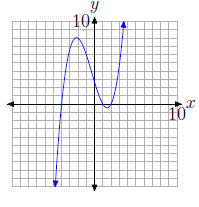
30.
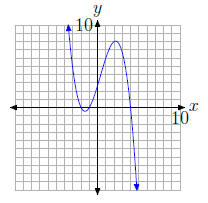
31.
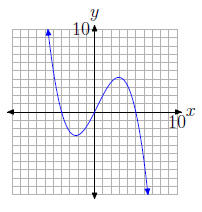
32.
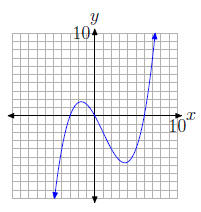
33.
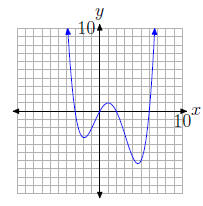
34.
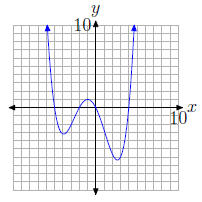
For each of the polynomials in Exercises 35-
46, perform each of the following tasks.
i. Factor the polynomial to obtain the
zeros. Show your work.
ii. Set up a coordinate system on graph
paper. Label and scale the horizontal
axis. Use the zeros and end-behavior
to help sketch the graph of the polynomial
without the use of a calculator.
iii. Verify your result with a graphing calculator.
35. p(x) = 5x3 + x2 − 45x − 9
36. p(x) = 4x3 + 3x2 − 64x − 48
37. p(x) = 4x3 − 12x2 − 9x + 27
38. p(x) = x3 + x2 − 16x − 16
39. p(x) = x4 + 2x3 − 25x2 − 50x
40. p(x) = −x4 − 5x3 + 4x2 + 20x
41. p(x) = −3x4 − 9x3 + 3x2 + 9x
42. p(x) = 4x4 − 29x2 + 25
43. p(x) = −x3 − x2 + 20x
44. p(x) = 2x3 − 7x2 − 30x
45. p(x) = 2x3 + 3x2 − 35x
46. p(x) = −2x3 − 11x2 + 21x
6.2 Solutions
1. p(−3) = (−3)3 − 3(−3)2 − 13(−3) + 15 = −27 − 27 + 39 + 15 = 0
3. p(4) = 44 − 43 − 12(4)2 = 256 − 64 − 192 = 0
5. p(−2) = (−2)4 + (−2)2 − 20 = 16 + 4 − 20 = 0
7. Set p(x) = 0 in p(x) = (x − 2)(x + 4)(x − 5),
0 = (x − 2)(x + 4)(x − 5),
then use the zero product property to write
x − 2 = 0 or x + 4 = 0 or x − 5 = 0.
Solving , the zeros are x = 2, −4, and 5.
9. Set p(x) = 0 in p(x) = −2(x − 3)(x + 4)(x − 2),
0 = −2(x − 3)(x + 4)(x − 2),
then use the zero product property to write
x − 3 = 0 or x + 4 = 0 or x − 2 = 0.
Solving , the zeros are x = 3, −4, and 2.
11. Set p(x) = 0 in p(x) = x(x − 3)(2x + 1),
0 = x(x − 3)(2x + 1),
then use the zero product property to write
x = 0 or x − 3 = 0 or 2x + 1 = 0.
Solving, the zeros are x = 0, 3, and −1/2.
13. Set p(x) = 0 in p(x) = −2(x + 3)(3x − 5)(2x + 1),
0 = −2(x + 3)(3x − 5)(2x + 1),
then use the zero product property to write
x + 3 = 0 or 3x − 5 = 0 or 2x + 1 = 0.
Solving, the zeros are x = −3, 5/3, and −1/2.
15. Factor p(x) = 3x3 + 5x2 − 12x − 20 by grouping, then
finish the factoring using
the difference of squares pattern.
p(x) = 3x3 + 5x2 − 12x − 20
p(x) = x2(3x + 5) − 4(3x + 5)
p(x) = (x2 − 4)(3x + 5)
p(x) = (x + 2)(x − 2)(3x + 5)
To find the zeros, set p(x) = 0,
0 = (x + 2)(x − 2)(3x + 5),
then use the zero product property to write
x + 2 = 0 or x − 2 = 0 or 3x + 5 = 0.
Solving, the zeros are x = −2, 2, or −5/3.
17. Factor p(x) = 2x3 +5x2 −2x−5 by grouping, then
finish the factoring using the
difference of squares pattern .
p(x) = 2x3 + 5x2 − 2x − 5
p(x) = x2(2x + 5) − 1(2x + 5)
p(x) = (x2 − 1)(2x + 5)
p(x) = (x + 1)(x − 1)(2x + 5)
To find the zeros, set p(x) = 0,
0 = (x + 1)(x − 1)(2x + 5),
then use the zero product property to write
x + 1 = 0 or x − 1 = 0 or 2x + 5 = 0.
Solving, the zeros are x = −1, 1, or −5/2.
19. Start with p(x) = x4 + 4x3 − 9x2 − 36x. Factor out
the gcf (x in this case), then
factor by grouping . In the last step, use the difference of squares pattern to
complete
the factorization.
p(x) = x[x3 + 4x2 − 9x − 36]
p(x) = x[x2(x + 4) − 9(x + 4)]
p(x) = x(x2 − 9)(x + 4)
p(x) = x(x + 3)(x − 3)(x + 4)
Set
0 = x(x + 3)(x − 3)(x + 4)
and use the zero product property to write
x = 0 or x + 3 = 0 or x − 3 = 0 or x + 4 = 0.
Solving, the zeros are x = 0, −3, 3, and −4.
21. Start with p(x) = −2x4 − 10x3 + 8x2 + 40x. Factor
out the gcf (−2x in this
case), then factor by grouping. In the last step , use the difference of squares
pattern
to complete the factorization.
p(x) = −2x[x3 + 5x2 − 4x − 20]
p(x) = −2x[x2(x + 5) − 4(x + 5)]
p(x) = −2x(x2 − 4)(x + 5)
p(x) = −2x(x + 2)(x − 2)(x + 5)
Set
0 = −2x(x + 2)(x − 2)(x + 5)
and use the zero product property to write
−2x = 0 or x + 2 = 0 or x − 2 = 0 or x + 5 = 0.
Solving, the zeros are x = 0, −2, 2, and −5.
23. Start with p(x) = 2x3 − 7x2 − 15x. Factor out the
gcf (x in this case), then use
the ac- method to complete the factorization.
p(x) = x[2x2 − 7x − 15]
p(x) = x[2x2 − 10x + 3x − 15]
p(x) = x[2x(x − 5) + 3(x − 5)]
p(x) = x(2x + 3)(x − 5)
Set
0 = x(2x + 3)(x − 5)
and use the zero product property to write
x = 0 or 2x + 3 = 0 or x − 5 = 0.
Solving, the zeros are x = 0, −3/2, and 5.
| Prev | Next |